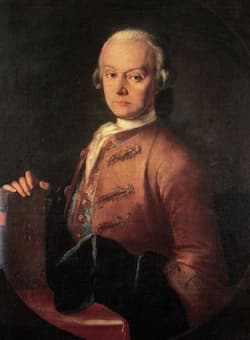
Leopold Mozart
On 27 January 1756 a boy was born to Leopold Mozart and his wife Anna Maria, née Pertl, in an apartment on the third floor of Getreidegasse 9 in the city of Salzburg. That particular house is still standing, and it proudly announces itself as the birthplace of Wolfgang Amadeus Mozart. The third floor apartment, in turn, now houses a small museum dedicated to the city’s most famous son. The boy was baptized at St Rupert’s Cathedral as Joannes Chrysostomus Wolfgangus Theophilus.
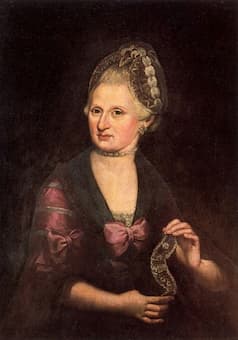
Anna Maria Mozart
The first two names simply mean that 27 January was the feast day of St John Chrysostom, while Wolfgangus was the name of his maternal grandfather and Theophilus a name of his godfather, the merchant Joannes Theophilus Pergmayr. In time, Mozart would sometimes prefer the Latin form of his name, Amadeus, but he favored Amadè, Amadé or the German form Gottlieb. Genealogy records reveal that the family name Mozart, in a variety of spellings, first appeared in the Augsburg region in the 14th century. Family members were master masons, builders, craftsmen and sculptors. Mozart’s great grandfather David was a master mason, and his grandfather Johann Georg a master bookbinder in Augsburg.
Wolfgang Amadeus Mozart: Minuet and Trio, K. 1
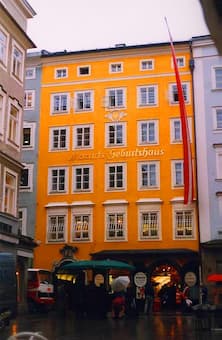
Mozart’s birthplace Getreidegasse 9 in the city of Salzburg
His father Leopold Mozart was an accomplished organist and violinist. Unwilling to go into the bookbinding business he escaped to Salzburg and studied philosophy and jurisprudence at the Benedictine University. Expelled for poor attendance, Leopold became a valet and musician to Count Thurn and Taxis, and subsequently graduated to deputy Kapellmeister in the court orchestra of Archbishop Leopold Anton Freiherr von Firmian. He married Anna Maria Pertl on 21 November 1747, and the “two were regarded at the time as the handsomest couple in Salzburg.” The Pertl family hailed from the greater Salzburg region, and her father Wolfgang Nikolaus Pertl was an important administrator in the courts. He was also a skilled musician, but a severe illness took his life on 7 March 1724. Wolfgang Amadeus was the seventh and last child to be born; only he and the fourth child, Maria Anna, nicknamed “Nannerl,” survived. Mozart’s father Leopold early on realized that his son Wolfgang, to whom he referred as the “miracle of God permitted to have been born in Salzburg,” had enormous musical talents. A scholar writes, “the recognition of this miracle must have struck Leopold with the force of a divine revelation and he felt his responsibility to be not merely a father’s and teacher’s but a missionary’s as well.”
Wolfgang Amadeus Mozart: Violin Sonata No. 2 in D Major, K. 7 (Gerard Poulet, violin; Blandine Verlet, harpsichord)
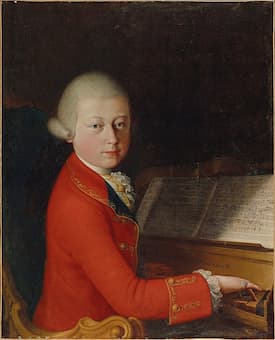
Wolfgang Amadeus Mozart at the age of 13 in Verona, 1770
During his early years, Leopold was Wolfgang’s and Nannerl’s only teacher. Along with music, he taught his children language and academic subjects, including, mathematics, reading, writing, literature, languages and dancing, as well as moral and religious subjects. Leopold recorded in the “Nannerl Notenbuch” that Wolfgang learnt some pieces when he was four, and his earliest known compositions emerged when he was five. There is still much debate whether Mozart was four or five years old, and what particular passages might have been aided by Leopold and or Nannerl, but without Leopold’s instructions, Wolfgang’s artistic development is unimaginable. Later biographers and tabloid journalists today are fond to characterize Leopold as excessively manipulative, intolerant, autocratic and jealous of his son’s talent.
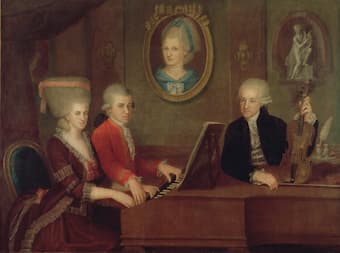
Leopold Mozart and his Children
But on the contrary, “Leopold Mozart may have been haughty, difficult to please and at times, but the family letters reveals a father who cared deeply for his son but who was frequently frustrated in his greatest ambition: to secure for Wolfgang a worldly position appropriate to his genius.” Leopold certainly fulfilled a “universal function as teacher, educator and private secretary to his son, and also served as valet, impresario, propagandist and travel organizer.”
Wolfgang Amadeus Mozart: “Va, dal furor portata,” K. 21
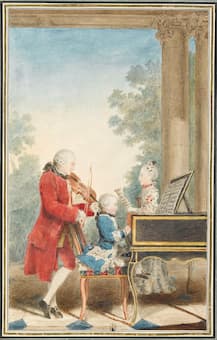
Mozart’s family on tour, 1763
By all accounts, the Mozart home was an unburdened place, and Wolfgang and Nannerl were allowed to be children. They played with a large group of friends from all social classes, and loved to shoot darts at highly decorated targets. Wolfgang loved to sing from an early age, and he absorbed everything having to do with music with a tremendous appetite and without effort. As Nannerl subsequently reports, “He often spent much time at the clavier, picking out thirds, which he was ever striking, and his pleasure showed that it sounded good. … In the fourth year of his age his father, for a game as it were, began to teach him a few minuets and pieces at the clavier… He could play it faultlessly and with the greatest delicacy, and keeping exactly in time… At the age of five, he was already composing little pieces, which he played to his father who wrote them down.” At the age of five, Wolfgang performed in public for the first time, participating in a musical comedy for the Prince-Archbishop of Salzburg. These carefree early years come to an abrupt end when Leopold Mozart, virtually abandoning his own career, presented Wolfgang and Nannerl as child prodigies around the courts and musical centers of Western Europe. Mozart was first exhibited in 1762 at the court of Maximilian III of Bavaria in Munich, and at the Imperial Courts in Vienna and Prague. Over the next three and half years, they visited the courts of Munich, Mannheim, Paris, London, Dover, The Hague, Amsterdam, Utrecht, Mechelen and once again Paris, and returned home via Zurich, Donaueschingen, and Munich. It was the first of five grand tours undertaken during the next decade.
For more of the best in classical music, sign up to our E-Newsletter
Wolfgang Amadeus Mozart: Symphony No. 4 in D major, K. 19
Read and discover Mozart’s series of music journey here.

He was exposed to Europe’s varied musical styles. And he chose what he loved. Mozart’s taste is unparalleled. That’s his genius.